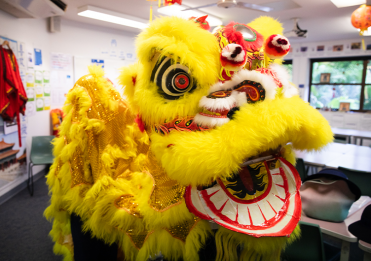3.45 pm Wednesday 25 March 2020: I closed up the Archive and walked over to the Main Building to have a quick look at the Museum so I could map out the display cases to plan the Open Day exhibition. However, that planning was to be abandoned and, leaving the quiet and empty old building, I felt as if I were leaving an ’old friend’. The place gets under your skin; it has a special feeling about it, as if it is guarding the secrets and stories of the pupils and staff over the past 136 years (since the opening of the School’s Main Building).
On Thursday 12 March 2020, the World Health Organization declared the outbreak of the COVID-19 virus a pandemic. This disease was highly contagious and, there was no vaccination. The outbreak of COVID-19 led to students learning remotely, while the campus remained open for those families who required their daughters to learn from school. The main goal was to provide certainty and structure for families and ensure that ‘students felt secure in their learning’ (Addison, 2020).
This was not the first time in the School’s history that the Main Building had witnessed the disruption of its residents’ lives, students and staff having endured disasters and epidemics. In the late 1870s there was an epidemic of typhoid fever—which left many students with their heads shorn (Walker, 1925)—that was later followed by a measles epidemic.
On Tuesday 25 May 1875, Mr Thomas Harlin, Head Master of Brisbane Grammar School, put an announcement in The Brisbane Courier, advising parents that, because of the measles outbreak in Brisbane and the risk of contagion to pupils, school would close early for the mid-year break. Dr Konrad Hirschfeld, in his personal writings on the School’s history, noted that, ‘In 1875 there were many cases of infectious fever and both the boys and girls suffered from the fevers as did their masters and mistresses … many schools both in New South Wales and Queensland were forced to close for a time. These illnesses, together with an increased number of pupils, made necessary a move to the new premises on Wickham Terrace in July 1875’ (Hirschfeld, 1980).
On Saturday 9 December 1893, The Telegraph reported that at Brisbane Grammar Schools ’The floods, epidemics and bank failures of the year had combined to repress the attendance, but happily the results of the years’ work have far exceeded expectation’.
Then there were the war years. The effects of World War I were traumatic and students suffered the fear of losing family members. Past students were victims of the conflict. Girls contributed to the war effort. Many Grammar women joined different branches of the War Services. They worked in ammunition factories, Red Cross, VAD, AIF WAAF, the Womens’ National Emergency League, as fire watchers and roof spotters, as well as Mine Watchers on the Brisbane River. Some became officers in the Australian Women’s Army Service, while others joined the Army Medical Corp, and qualified nurses went to Europe to work in hospitals on the war front.
On the announcement, in November 1918, of the end of the war, students were in class and, as the wave of news travelled throughout the building, applause broke out in classroom after classroom (BGGS Magazine, 1918). Imagine, if you can, the noise those 283 pairs of hands, led by Head Mistress, Miss Annie Mackay, would have made, echoing from all parts of the building. It is reminiscent of the applause for health workers that is part of the response to the coronavirus isolation endured by people all around the world.
The opening words of the 1919 December edition of the BGGS Magazine remind us that for those who survived the trauma of the war years, still more lay ahead. Following the end of that dreadful war came the Spanish flu. ‘The old year lies “a-dying” but where are his mourners? We stand around his death bed with scarcely one thought of regret for it would be impossible to say that 1919 has been a satisfactory year’ (BGGS Magazine, 1919).
It was not until March 1919, five weeks after the beginning of the School year, that a number of staff, who had spent their Christmas holidays ’down South’, finally managed to get back to work. Queensland’s borders had been closed since Christmas 1918 in an attempt by the Government to stop the spread of the pneumonic influenza, which had taken hold of the southern states. Deja vu 2020, perhaps? Closing the borders did not hold back the spread of the virus and after the Easter holidays the Queensland Government closed all schools, and by June the Brisbane Commissioner of Public Health had put restrictions on churches, theatres, and public meetings.
Students learned by distance—mailing work to staff. Sixth Formers noted that during the time they were at home, they ‘worked very hard and the class mistresses received many important missives by post’, one student even claiming to have sent 41 algebraic problems to her teacher (BGGS Magazine, 1919). Only junior and senior candidates, who were sitting the Public Examinations at the end of the year, remained on campus. Twenty-two of the 346 students had the run of the School for 11 weeks until it re-opened in July.
Schools closed again in Queensland, three years after the start of World War II, because of the Government’s concern for the safety of children after the bombing of Darwin. An extract from a letter written by Grammar Woman, Ena Dalton (1931), recalls how events unfolded in Darwin on Thursday 19 February 1942. On that day, Ena left for work as usual—her office was located next door to the Naval Base—and when the anti-aircraft alarm went off, Ena and the rest of the staff sought safety in their shelter constructed of oil drums in the backyard. Ena tells her reader that she was fortunate to have survived that day, as many were not so blessed (Dalton, 1942).
Students returned to school in March 1942 only to find that ‘a huge red cross on a white disk had been painted on the roof (Main Building). We were told it was because the building would be turned into a hospital should there be an invasion. All windows had been taped with strips of white sticky paper to prevent them from splintering badly in bomb blasts. These we were told were normal precautions taken in Britain from their experience of air raids’ (Fearnley, 2002).
‘We found zig-zag slit trenches had been dug both sides of the School. At assembly it was explained what we should do if an air raid should indeed happen. The School bell would be rung and continue ringing to let us know we were having Air Raid Practice. If it were an actual air raid, then we would also hear the city’s official air raid sirens with their rising and falling wail. Whichever we heard, we were to drop what we were doing, even in the middle of class or a sport, go and collect our cushion (on which to sit), cotton wool ear plugs, wooden peg (to put between our teeth), and a square of khaki or green material—that was to place over our back in this slit trench to hide our white blouses and/or hat. A line of white blouses would be easily noticed by an enemy fighter pilot with his machine gun. Each form had been allocated a particular section of trench, usually the closest to their classroom. Two 6th Formers were allocated to each form and its Form Mistress. During the week, we assembled all our kits for the trench, and then followed a practice air raid drill about once a week, without warning. I brought a rubber cushion in a brown cover on which to sit, a square piece of material dyed brown with Condy’s crystals as a back cover, but I thought the ear plug business was a bit silly and always ”forgot” to bring the cotton wool’(Fearnley, 2002).
Forever resourceful, students described how they filled their time while seated in the trenches—reading, knitting, chatting in noisy social circles, digging in the soil and collecting insects, and expressed the relief they felt when the all clear was called (BGGS Magazine, 1942).
When swine flu reached Australian shores in 2009, there were reports in newspapers that the virus disproportionately affected children and young adults, and that the epidemic spread rapidly in schools. Girls Grammar closed on 14 June (Sunday Mail, 2009), a week short of the mid-year holiday break, and staff stayed on campus to teach their classes remotely. Principal, Dr Amanda Bell, reflected in BGGS News that it was a Term ‘best forgotten’ and that the School community should ’look with optimism to the future’ which, with the decline of the virus, they were able to do once School resumed in Term 3.
Like so many of the girls and staff before us who have experienced time away, the ‘The Dear Old School’ stands waiting for us all when routine, lessons, time tables, and school life return. We, too, will have a great deal to record and recollect about our experiences and recovery from these extraordinary times.
Mrs Jenny Davis
Librarian—Special Collections
References
Addison, Bruce. (2020). Letter to Academic Staff, 23 March
Walker, Aline. (1925). A few memories of a very old, old girl! Brisbane Girls Grammar School Magazine, p. 5.
Harlin, Thomas. (1875). Brisbane Grammar School—Girls’ School. Brisbane Courier, May p. 1.
Hirschfeld, Dr. Konrad. (c.1980) Dr. Konrad Hirschfeld’s Personal Notes in the BGGS Archive, pp. 1-2
Grammar School. (1893). The Telegraph, Saturday 9 December, p. 4.
Peace Demonstrations. (1918). Brisbane Girls Grammar School Magazine, December, p. 20
Editorial. (1919). Brisbane Girls Grammar School Magazine, December, p. 3.
Mackay, Miss Annie. (1919) 28 November 1919, Head Mistress’s Report to the Board: General
VI Form Notes. (1919). Brisbane Girls Grammar School Magazine, December, p. 8.
Dalton, Ena. (1942). Letter from Ena Dalton, Mataranka, NT to Mrs E Wetherell. Brisbane Girls Grammar School Magazine, December, p. 43.
Fearnley, Cecily. (2002). ‘Wartime Experience of Cecily Lydia Sandercock, pp. 19 – 20
Highlights from the Trenches. (1942). Brisbane Girls Grammar School Magazine, June, p.26
Swine Flu closes BGGS. (2009). Sunday Mail, 14 June.
Bell, Dr. Amanda. (2009). From the Principal. BGGS News Vol 28, Number 18, 19 June.




